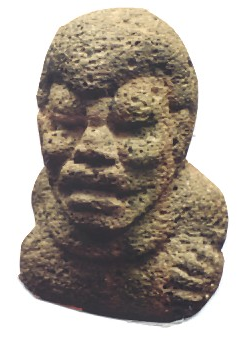By John J. White, III
Originally published in The Midwestern Epigraphic Journal Volume 16
Reporting and interest in ancient history is rather ethnocentric. The shortage of authors with Black African heritage leads to an understatement of Black African participation in Cultural Diffusion to the Americas. The leading contributor by far is Professor Ivan Van Sertima, who wrote the inspiring book They Came Before Columbus. He reports Mandinga Nubian and Egyptian travelers to ancient America in his many books.
In the early 1990’s I read widely for research possibilities. I reviewed Lighting Bird, a description of the adult life of epileptic white visitor Adrian Boshier, who became a notable South African witch doctor. I gave a lecture on the exploration story of the Mandinga King Abubakari II. There are many Black African portraits in the Burrows Cave collection. We published a photograph of a beautiful Mexican sculpture of a Black African sailor on display at the Museum of Ceramic Art in Toronto. I have been collecting material for an article on the West African sea goddess “Mami Wata”, who may have originated in India.
The leading Black African story is the occurrence of a dozen black African-like faces carved on naturally occurring ten-foot diameter bodies found in the Gulf Coast region of La Venta. They are associated with the so-Olmec culture of the first millenium BCE, which appears to have a great deal of Chinese heritage, possibly Late Shang. The large Olmec Heads are representations of military men with helmets and faces that are not likely to be Native American in origin. The establishment would have us believe that these are Beringa-type Native Americans with variations attributable to artist conceptions.
My model is that the Carthaginians settled a large “army” of black Africans at key places on Gulf Coast Mexico to provide protection for its trading posts, which operated as permanent stations. These black Africans had “kings/Generals” represented on Olmec Heads. The adjoining photographs of an alleged Olmec figures are given to support the argument that black Africans lived in Olmec Mexico. The women was displayed at the amazing Gil Crease Museum in Tulsa. The man was located at the fabulous Princeton University Art Museum. Absent the head gear, the hair and features suggest West African origins.
1. Ivan Van Sertima, They Came Before Columbus, Random House, New York, 1976, 288p.
2. JJ White, “Book Review of Lightning Bird, The Story of One Man’s Journey into Africa by Lyall Watson”, E.P. Dutton Inc, NY, 1982, ESOP 20, 25 (1991).
3. JJ White, “The Voyage of King Abubakari II to America in 1311 AD”, MES Quarterly Meeting, Feb 8, 1992.
4. “Featured photograph, Mexican Sculpture of a Black African Sailor”, MENL 14(4), 1p (1997).





